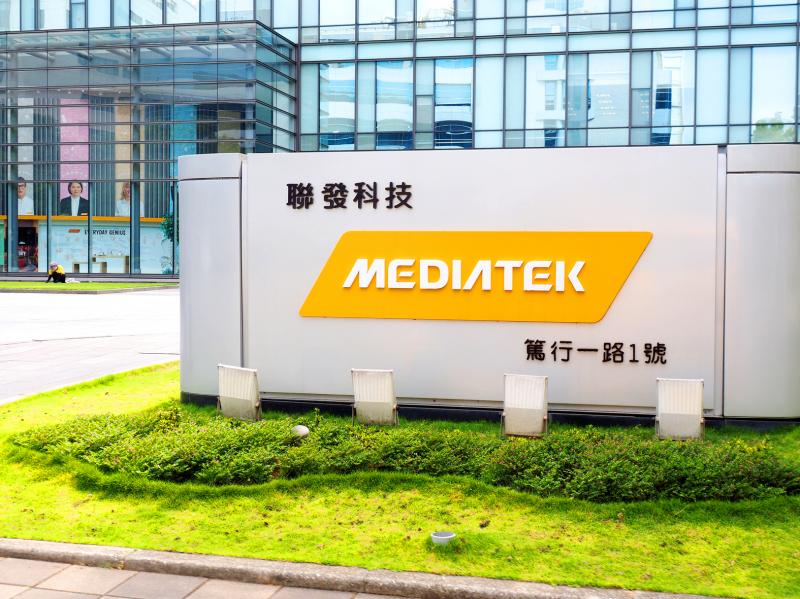MediaTek Inc (聯發科) this year expects to ship more than 45 million units of its 5G system-on-a-chip (SoC), dubbed the Dimensity series, on the back of broader product portfolios and availability in more markets beyond China, company executives said yesterday.
The Hsinchu-based chipmaker said it has expanded its 5G footprint to North America, Europe, Middle East and Southeast Asian countries.
Next year, the company aims to expand its reach to South America, Africa, Eastern Europe, India, Japan and South Korea, it said.

Photo: David Chang, EPA-EFE
MediaTek’s forecast is more conservative than an estimate of 48 million units by SinoPac Securities Investment Service Corp (永豐投顧).
The investment consultant expects 5G SoCs to contribute 16 percent of the chipmaker’s revenue this year.
MediaTek, the world’s second-largest handset chip supplier, said it plans to introduce a new premium 5G SoC made using 6-nanometer technology in the near term.
The new chip would be powered by ARM Cortex-A78 core technology, it said in a statement.
That would boost the performance of the new premium 5G chips, compared with the Dimensity 1000+, the most advanced 5G chip available from MediaTek powered by ARM Cortex-A77 core technology.
The company yesterday also launched its new 5G chip, Dimensity 700, targeting mid-range 5G smartphones, as well as two new chipsets, MT8195 and MT1892, amid rising demand for Chromebooks due to work-from-home and online-learning trends.
Chromebooks equipped with the MT8192 chipset would be available in the second quarter of next year, it added.
MediaTek plans to invest more than US$2.5 billion on research and development this year, it said.
MediaTek reported that revenue last month dropped 19.61 percent month-on-month to NT$30.44 billion (US$1.05 billion) from NT$37.87 billion, as the company received no rush orders from Huawei Technologies Co (華為).
Last month’s figure represented an annual growth of 38.34 percent from NT$22 billion.
In the first 10 months of this year, revenue totaled NT$256.18 billion, up 25.88 percent year-on-year.

IN THE AIR: While most companies said they were committed to North American operations, some added that production and costs would depend on the outcome of a US trade probe Leading local contract electronics makers Wistron Corp (緯創), Quanta Computer Inc (廣達), Inventec Corp (英業達) and Compal Electronics Inc (仁寶) are to maintain their North American expansion plans, despite Washington’s 20 percent tariff on Taiwanese goods. Wistron said it has long maintained a presence in the US, while distributing production across Taiwan, North America, Southeast Asia and Europe. The company is in talks with customers to align capacity with their site preferences, a company official told the Taipei Times by telephone on Friday. The company is still in talks with clients over who would bear the tariff costs, with the outcome pending further

WEAKER ACTIVITY: The sharpest deterioration was seen in the electronics and optical components sector, with the production index falling 13.2 points to 44.5 Taiwan’s manufacturing sector last month contracted for a second consecutive month, with the purchasing managers’ index (PMI) slipping to 48, reflecting ongoing caution over trade uncertainties, the Chung-Hua Institution for Economic Research (CIER, 中華經濟研究院) said yesterday. The decline reflects growing caution among companies amid uncertainty surrounding US tariffs, semiconductor duties and automotive import levies, and it is also likely linked to fading front-loading activity, CIER president Lien Hsien-ming (連賢明) said. “Some clients have started shifting orders to Southeast Asian countries where tariff regimes are already clear,” Lien told a news conference. Firms across the supply chain are also lowering stock levels to mitigate

NEGOTIATIONS: Semiconductors play an outsized role in Taiwan’s industrial and economic development and are a major driver of the Taiwan-US trade imbalance With US President Donald Trump threatening to impose tariffs on semiconductors, Taiwan is expected to face a significant challenge, as information and communications technology (ICT) products account for more than 70 percent of its exports to the US, Chung-Hua Institution for Economic Research (CIER, 中華經濟研究院) president Lien Hsien-ming (連賢明) said on Friday. Compared with other countries, semiconductors play a disproportionately large role in Taiwan’s industrial and economic development, Lien said. As the sixth-largest contributor to the US trade deficit, Taiwan recorded a US$73.9 billion trade surplus with the US last year — up from US$47.8 billion in 2023 — driven by strong

RESHAPING COMMERCE: Major industrialized economies accepted 15 percent duties on their products, while charges on items from Mexico, Canada and China are even bigger US President Donald Trump has unveiled a slew of new tariffs that boosted the average US rate on goods from across the world, forging ahead with his turbulent effort to reshape international commerce. The baseline rates for many trading partners remain unchanged at 10 percent from the duties Trump imposed in April, easing the worst fears of investors after the president had previously said they could double. Yet his move to raise tariffs on some Canadian goods to 35 percent threatens to inject fresh tensions into an already strained relationship, while nations such as Switzerland and New Zealand also saw increased